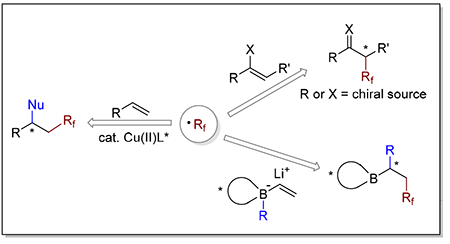| [1] (a) Furuya, T.; Kamlet, A. S.; Ritter, T. Nature 2011, 473, 470.
(b) Shimizu, M.; Hiyama, T. Angew. Chem., Int. Ed. 2005, 44, 214.
[2] Lehmann, F. Arch. Exp. Pathol. Pharmakol. 1928, 130, 250.
[3] Kirsch, P. Modern Fluoroorganic Chemistry, Synthesis, Reactivity, Applications, Wiley-VCH, Weinheim, 2004.
[4] (a) Ma, J.-A.; Cahard, D. Chem. Rev. 2004, 104, 6119.
(b) Ma, J.-A.; Cahard, D. Chem. Rev. 2008, 108, PR1.
(c) Nie, J.; Guo, H.-C.; Cahard, D.; Ma, J.-A. Chem. Rev. 2011, 111, 455.
[5] Dolbier, W. R. Chem. Rev. 1996, 96, 1557.
[6] (a) Studer, A. Angew. Chem., Int. Ed. 2012, 51, 8950.
(b) Wang, X.; Zhang, Y.; Wang, J. Sci. Sin. 2012, 42, 1417.
[7] Pan, X.; Xia, H.; Wu, J. Org. Chem. Front. 2016, 3, 1163.
[8] Wang, F.; Chen, P.; Liu, G. Acc. Chem. Res. 2018, 51, 2036.
[9] (a) Fessenden, R. W.; Schuler, R. H. J. Chem. Phys. 1965, 43, 2704.
(b) Krusic, P. J.; Bingham, R. C. J. Am. Chem. Soc. 1976, 98, 230.
[10] (a) Wang, S.-M.; Han, J.-B.; Zhang, C.-P.; Qin, H.-L.; Xiao, J.-C. Tetrahedron 2015, 71, 7949.
(b) Chatterjee, T.; Iqbal, N.; You, Y.; Cho, E. J. Acc. Chem. Res. 2016, 49, 2284.
(c) Wang, X.; Studer, A. Acc. Chem. Res. 2017, 50, 1712.
(d) Barata-Vallejo, S.; Cooke, M. V.; Postigo, A. ACS Catal. 2018, 8, 7287.
[11] (a) Iseki, K.; Nagai, T.; Kobayashi, Y. Tetrahedron Lett. 1993, 34, 2169.
(b) Iseki, K.; Nagai, T.; Kobayashi, Y. Tetrahedron:Asymmetry 1994, 5, 961.
[12] Itoh, Y.; Mikami, K. Tetrahedron 2006, 62, 7199.
[13] Nagib, D. A.; Scott, M. E.; MacMillan, D. W. C. J. Am. Chem. Soc. 2009, 131, 10875.
[14] Wozniak, L.; Murphy, J. J.; Melchiorre, P. J. Am. Chem. Soc. 2015, 137, 5678.
[15] Herrmann, A. T.; Smith, L. L.; Zakarian, A. J. Am. Chem. Soc. 2012, 134, 6976.
[16] Huo, H.; Huang, X.; Shen, X.; Harmsa, K.; Meggers, E. Synlett 2016, 27, 749.
[17] Liu, J.; Ding, W.; Zhou, Q.-Q.; Liu, D.; Lu, L.-Q.; Xiao, W.-J. Org. Lett. 2018, 20, 461.
[18] Yajima, T.; Nagano, H. Org. Lett. 2007, 9, 2513.
[19] Zhu, R.; Buchwald, S. L. Angew. Chem., Int. Ed. 2013, 52, 12655.
[20] Miller, Y.; Miao, L.; Hosseini, A. S.; Chemler, S. R. J. Am. Chem. Soc. 2012, 134, 12149.
[21] Wang, F.; Wang, D.; Wan, X.; Wu, L.; Chen, P.; Liu, G. J. Am. Chem. Soc. 2016, 138, 15547.
[22] Wu, L.; Wang, F.; Wan, X.; Wang, D.; Chen, P.; Liu, G. J. Am. Chem. Soc. 2017, 139, 2904.
[23] Fu, L.; Zhou, S.; Wan, X.; Chen, P.; Liu, G. J. Am. Chem. Soc. 2018, 140, 10965.
[24] Yu, P.; Lin, J.-S.; Li, L.; Zheng, S.-C.; Xiong, Y.-P.; Zhao, L.-J.; Tan, B.; Liu, X.-Y. Angew. Chem., Int. Ed. 2014, 53, 11890.
[25] Li, T.; Yu, P.; Du, Y.-M.; Lin, J.-S.; Zhi, Y.; Liu, X.-Y. J. Fluorine Chem. 2017, 203, 210.
[26] Lin, J.-S.; Dong, X.-Y.; Li, T.-T.; Jiang, N.-C.; Tan, B.; Liu, X.-Y. J. Am. Chem. Soc. 2016, 138, 9357.
[27] Lin, J.-S.; Wang, F.-L.; Dong, X.-Y.; He, W.-W.; Yuan, Y.; Chen, S.; Liu, X.-Y. Nat. Commun. 2017, 8, 14841.
[28] Cheng, Y.-F.; Dong, X.-Y.; Gu, Q.-S.; Yu, Z.-L.; Liu X.-Y. Angew. Chem., Int. Ed. 2017, 56, 8883.
[29] Li, X.-T.; Gu, Q.-S.; Dong, X.-Y.; Meng, X.; Liu, X.-Y. Angew. Chem., Int. Ed. 2018, 57, 7668.
[30] Kischkewitz, M.; Okamoto, K.; Mück-Lichtenfeld, C.; Studer, A. Science 2017, 355, 936.
[31] Gerleve, C.; Kischkewitz, M.; Studer, A. Angew. Chem., Int. Ed. 2018, 57, 2441. |
